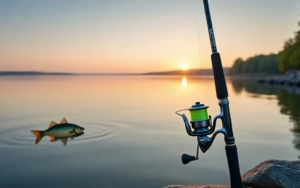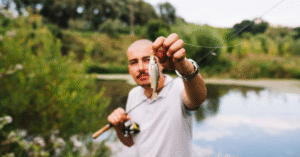Introduction To Fishing Tips: Why Bass Fishing is So Popular
Let me take you back to my first time trying to catch a largemouth bass. I was standing knee-deep in a pond outside of Nashville, Tennessee, holding a borrowed rod and not a clue what I was doing. Just when I was about to give up, BAM! A five-pounder hit my bait like a freight train. That moment got me hooked—pun intended.
Fishing Tips, why is bass fishing such a big deal in America? Well, it’s thrilling, unpredictable, and accessible. Whether you’re on a fancy boat with sonar tech or just casting from a muddy riverbank, the thrill of the catch is the same.
The U.S. is home to a wide variety of bass species—especially largemouth, smallmouth, and spotted bass. Whether you’re a beginner or seasoned angler, there’s always something new to learn.
Understanding Bass: Know Your Target
Before you can catch a bass, you need to understand how they think. That means knowing:
- Species Differences: Largemouth bass, smallmouth bass, and spotted bass each behave differently.
- Bass Behavior: They’re ambush predators that hide near cover—like weeds, logs, or rocks—and strike when prey comes close.
- Feeding Patterns: Bass love shad, minnows, worms, and even frogs. They feed more aggressively in warm water and during low-light hours like dawn or dusk.
Pro Tip: If you want to understand bass, think like one. Where would you hide if you were trying to ambush dinner?
Essential Bass Fishing Gear
Let’s break down the basic bass fishing gear you’ll need.
1. Fishing Rod and Reel
- A medium-heavy spinning rod (6’6″–7’0″) is a solid choice.
- Pair it with a spinning reel with a smooth drag system.
- More advanced anglers often use baitcasting reels, but they take practice.
2. Fishing Line
- Monofilament line is forgiving and good for beginners.
- Fluorocarbon is nearly invisible underwater.
- Braided line offers great strength for pulling bass out of heavy cover.
3. Tackle Box Must-Haves
- Hooks (sizes 2–5/0 depending on bait)
- Sinkers
- Swivels
- Pliers
- Soft plastic lures and hard baits
Pro Tip: Check out Bass Pro Shops for gear bundles specifically for bass fishing.
Best Time and Weather for Bass Fishing
Bass don’t just bite at any time—timing matters.
Time of Day
- Early morning and late evening are prime hours.
- Bass feed actively in low-light conditions.
Seasons
- Spring: Bass spawn in shallow waters. Great time to fish!
- Summer: Bass move deeper during hot afternoons.
- Fall: Bass feed aggressively to fatten up for winter.
- Winter: Fishing slows, but big bass can still be caught deep.
Weather
- Overcast days = better topwater action.
- Warm fronts = more active bass.
- Cold fronts = slower bite.
For local weather patterns and fishing forecasts, use AccuWeather Fishing Forecast.
Top Bass Fishing Techniques
Here are some tried-and-true bass fishing techniques every angler should know.
1. Casting and Retrieving
Simple and effective. Cast your lure out, then reel it in at various speeds.
2. Flipping and Pitching
Short-distance techniques perfect for heavy cover areas like weeds and docks.
3. Drop Shotting
Keeps your bait off the bottom and right in front of a bass’s nose. Great for clear water.
4. Jigging
Mimics injured prey and works well near structure.
Each of these techniques can be mastered over time, so don’t worry if they feel tricky at first.
Bait and Lures: What Really Works
Bass are picky eaters. What works in Florida might flop in Michigan. But some baits are universally effective.
Live Bait
- Minnows
- Shad
- Nightcrawlers
- Frogs
Artificial Lures
- Crankbaits: Great for covering lots of water.
- Spinnerbaits: Good for murky water.
- Soft Plastics (like worms or craws): Extremely versatile.
- Topwater Lures: For explosive strikes on the surface.
Want to explore different lure types? Check out Tackle Warehouse for detailed guides and reviews.
Best Spots to Catch Bass
Bass love hiding. You’re more likely to find them near:
- Weed beds
- Logs and stumps
- Rock piles
- Dock pilings
- Ledges and drop-offs
Lakes vs Rivers
- In lakes, fish near points, coves, and sunken structures.
- In rivers, look for eddies, current breaks, and shady banks.
To find hotspots near you, use the Fishbrain App, which shows where other anglers are catching bass.
Step-by-Step Guide: How to Catch Bass Like a Pro
Here’s your step-by-step bass fishing guide, beginner-friendly and proven.
Step 1: Choose the Right Location
- Use a local fishing map or app.
- Look for structures and cover areas.
Step 2: Select the Correct Gear
- Rod, reel, and line as described above.
- Match your lure to water clarity and season.
Step 3: Cast Smart
- Cast near cover.
- Vary your retrieve speed to mimic wounded prey.
Step 4: Feel for the Bite
- A bass bite might feel like a tap or like the line suddenly went slack.
- When in doubt—set the hook!
Step 5: Set the Hook
- Snap the rod back firmly to drive the hook in.
Step 6: Play the Fish
- Don’t muscle it in. Let the drag system do its job.
- Keep steady pressure and steer it away from cover.
Step 7: Land Your Bass
- Use a net if possible.
- Wet your hands before touching the fish to protect its slime coat.
Step 8: Release or Keep
- For catch and release, handle gently and return quickly.
- If you’re keeping it, make sure you follow state regulations.
Common Mistakes and How to Avoid Them
Even seasoned anglers slip up. Here are common errors:
- Using the wrong bait for the season or water clarity
- Fishing too fast when bass are sluggish
- Setting the hook too early or too late
- Ignoring local regulations
- Skipping proper line maintenance
Avoid these, and your success rate will skyrocket.
Bass Fishing Tips from Real Anglers
Here are some gems I’ve picked up over the years:
- “Slow down when nothing’s biting. The fish might be there, just not hungry yet.” – Rick M., Alabama
- “Use natural-colored lures in clear water and bright ones in muddy water.” – Jordan H., Missouri
- “If you’re not getting snagged once in a while, you’re not fishing near the cover.” – Lisa T., Texas
Final Thoughts
Bass fishing isn’t just a hobby—it’s a passion, a challenge, and a great way to connect with nature. Whether you’re a beginner with a budget rod or a seasoned angler with high-end gear, what matters most is time on the water and the memories made.
And remember, every expert was once a beginner. So get out there, cast a line, and enjoy the thrill of the chase.




